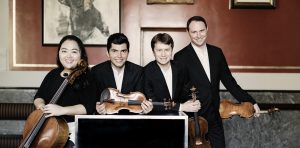
By Ava Figliuzzi
Name any major U.S. chamber music competition, and it has likely been won in the past by the Calidore String Quartet.
The New York City-based ensemble was the recipient of a 2018 Avery Fisher Career Grant, a 2017 Lincoln Center Emerging Artist Award, and the winner of the 2016 M-Prize International Chamber Music Competition. Their 2022-23 season balances international touring with a teaching residency at the University of Delaware, and included a concert Jan. 15 at the Society of the Four Arts in Palm Beach.
Opening the program was Bedřich Smetana’s First String Quartet (From My Life) — a quirky, autobiographical work that weaves Czech folk idioms into European Romanticism. An unsettling lightning strike of E minor followed by an eerie, static bed of sound sets the first movement into motion. Violist Jeremy Berry interjected with one of the chamber repertoire’s cardinal viola solos, laying it down with a comfortable facility.
Midway through the movement, Smetana provides relief from the Sturm und Drang, and Calidore’s strength could be seen in the natural breathing between phrases. The four players acted as one, giving a most convincing monologue with all the lilts and idiosyncrasies of organic speech. Their strength held at the ensemble and individual level; cellist Estelle Choi played as if engrossed in an incredibly nuanced conversation with each note.
The second movement, depicting Smetana’s youthful years, is written in the style of a Czech polka. Calidore’s execution of its rubato was nothing short of astounding. Each peak and pull held joy, and a satisfying drive came from all corners of the quartet.
The Largo sostenuto third movement highlighted second violinist Ryan Meehan’s impeccable tone and ability to jump between blending and singing over the top of the other members with grace. Chords were beautifully balanced to the inner voices, one of the many standout abilities possessed by Calidore throughout the program. The work finished with racing virtuosity from all, before coming to a touching, unhurried finish.
Meehan took a moment to explain the autobiographical nature of the quartet, referencing how Smetana onomatopoeically wrote an attack of tinnitus (a high harmonic in the first violin) into the finale — a detail not included in the written program notes.
Selected movements from At the Octoroon Balls, a quartet by jazz legend Wynton Marsalis, followed. Meehan again took a moment to speak to the audience, priming them with guidance to assuage the anxieties that come with lesser-known works. First was the third movement, “Creole Contradances,” a series of swaggering melodies and jazz harmonies over a groove of pizzicato and ricochet strokes. First violinist Jeffrey Myers navigated the constant demands of Marsalis’s double-stopped, capricious writing as if his fingerboard was a seaside highway on a sunset joyride. Meehan also shone in this movement with an improvisatory-sounding solo.
The fourth movement, “Many Gone,” hit listeners with a hefty cello cadenza. With twisting lines as dense and double-stopped as a first violin part, Choi played with an entrancing, magnetic solo sound. The tutti sections gave off the feel of sticky, unbearable summer heat, perforated by Choi’s vibrating intensity and Berry’s jovial folk melody over a drone. Myers elicited a smattering of giggles with a few startling stomps (with feet, yes) near the end of the movement.
For the final selection, “Hellbound Highball,” it was easy to imagine trains — as Meehan had earlier suggested. The cluster harmonies recalled the Second Viennese School and locomotive bow strokes were as powerful and consistent as brute machinery. Even more astonishing than the Calidore’s command over a contemporary style was the collection of colors within each dynamic. Towards the end of this movement, a terrifying pianissimo materialized; then, chugging back into motion, a modernized tribute to the middle movement of the Second String Quartet of Bartok.
After intermission came Felix Mendelssohn’s grief-stricken String Quartet No. 6 (in F minor, Op. 80), his last contribution to the genre, written following the death of his sister, Fanny, and only two months before his own death at age 38 in November 1847. Although the audience reacted with enthusiasm to the Marsalis, the patron seated behind me felt the need to whisper loudly after the first movement of the Mendelssohn, “Well, that’s a big change. What a relief!”
Myers made the bold decision to keep the nervous scrubbing motive of the first movement as an off-the-string, bounced stroke, only possible with the highest level of bow control. He provided the anguished derangement Mendelssohn writes into catapulting, wailing lines, effective even into the highest ranges of the violin. Myers, and indeed all the quartet members, did not show physical and emotional restraint when portraying characters.
Their third movement was profound, the program’s high point for many in the audience seen unabashedly wiping their eyes. The seamless bowing, pristine tone, and infallible voicing and intonation would humble even the most seasoned quartet players. The finale poses a technical challenge in the rapid string crossings first heard in the cello part. This obstacle did not affect the tempo, and the clarity and power presented by all members of the quartet were thrilling. Notably strong in this movement was the intensity and projection from Berry.
Beyond their technical expertise, the Calidore String Quartet inspires in all senses of the word. It is always a joy to watch them play, and live performances should be sought out and cherished by all who love the genre.